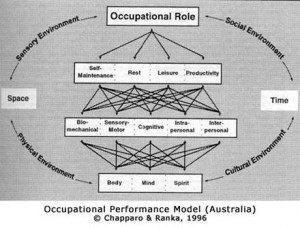CONSTRUCT 6: EXTERNAL ENVIRONMENT
The external environment is all the conditions surrounding a person, and has been classified in various ways. This model categorises the external environment as an interactive sensoryphysical- sociocultural phenomenon (Fig. 7).
The interaction of these four environmental dimensions creates further sub-dimensions such as political and economic environments that act as a filter between the internal and external April, 1997, Monograph 1 14 environment and profoundly affect occupational performance. Although aspects of this environment are defined separately, the environmental impact that is brought to bear on occupational performance is an integration of sensory, physical, social and cultural dimensions (Llorens, 1984b, Spencer, 1987). Arrows connecting all four dimensions of the external environment reflect this.
Physical aspects of the environment refer to the natural and constructed surroundings that form physical boundaries. This physical environment contributes to shaping occupational performance by influencing the extent to which selfmaintenance, productivity, leisure and rest occupations can be performed. Although the physical environment is often viewed as tangible, it is partially shaped by other environmental dimensions. For example, sociocultural environmental influences determine the way a physical environment looks. A large city in a western society with its tall buildings made of glass and steel has quite different physical dimensions to a tropical village on a Pacific island. Sensory aspects of the environment also contribute to its physical characteristics. Differences in the style, structure and physical components of an Arctic environment are quite different to those in a desert environment.
Figure 7: External Environment and its relationship to other constructs in the Occupational Performance Model
The sensory environment links most directly to the sensory and cognitive components of the internal environment and provides the natural cues that direct occupational performance. Fundamental to information supplied by the sensory environment is information about its survivability. For example, determining whether an environment is too hot or too cold to sustain life; too noisy to support rest or work occupations or too visually confusing to support concentration. Occupational Performance Model (Australia) 15
Culture here refers to transmitted patterns of behaviour shared by members of a group which provide them with effective mechanisms for interaction (Krefting & Krefting, 1991). Culture can be thought of as an overriding concept (eg. western cultures and indigenous cultures) that directs the sociocultural specificity of group environments each with its own beliefs and rituals that are used to determine behavioural norms.
Humans are social creatures. Some theorists have suggested that the social environment is constructed of several layers (Llorens, 1984b; Barris, Keilhofner, Levine & Neville, 1985). These layers have been developed based on notions of degrees of intimacy occurring between people in a family, neighbourhood, community and wider society (Llorens, 1984b). Many occupational performance roles are carried out within differing social environments that carry with them codes of behaviour in the form of expected social roles. Occupational performance roles established within these social environments and the level of mastery is not only based on individual choice but also on social expectations. Therefore, one of the major influences on occupational role performance is the degree of fit between occupational performance roles and the social environment.
The relationship that exists between the previous constructs and the external environment is profound and complex as illustrated in Figure 7. Many occupational performance roles, routines, tasks and subtasks are performed specifically in response to external demands leading to constant adaptation of occupational behaviour. Similarly, occupational performance which occurs within the external environment, can function to maintain environmental influences or change them. This adaptation process can be observed or analysed from the perspective of the impact of environmental dimensions on occupational performance and/or the impact of the performer on the environment.
Physical Environment refers to the natural and constructed surroundings of a person, which form physical boundaries and contribute to shaping behaviour.
Sensory Environment refers to the sensory surroundings of a person. Sensory aspects of the environment give a person information about the physicalsociocultural aspects of the environment and its survivability.
Cultural Environment refers to an organised structure which is composed of systems of values, beliefs, ideals and customs which are learned and communicated to contribute to the behavioural boundaries of a person or group of people.
Social Environment refers to an organised structure created by the patterns of relationships between people who function in a group which in turn contributes to establishing the boundaries of behaviour.
Analysis of Occupational Performance: External Performance Environment
Analysis of occupational performance at this level of the model considers:
- the degree to which present and future performance environments interfere with occupational role performance and the degree to which they support it.
- the potential for modification of the physicalsensory- sociocultural environment. Transactions within the six constructs already outlined occur within dimensions of space and time.

